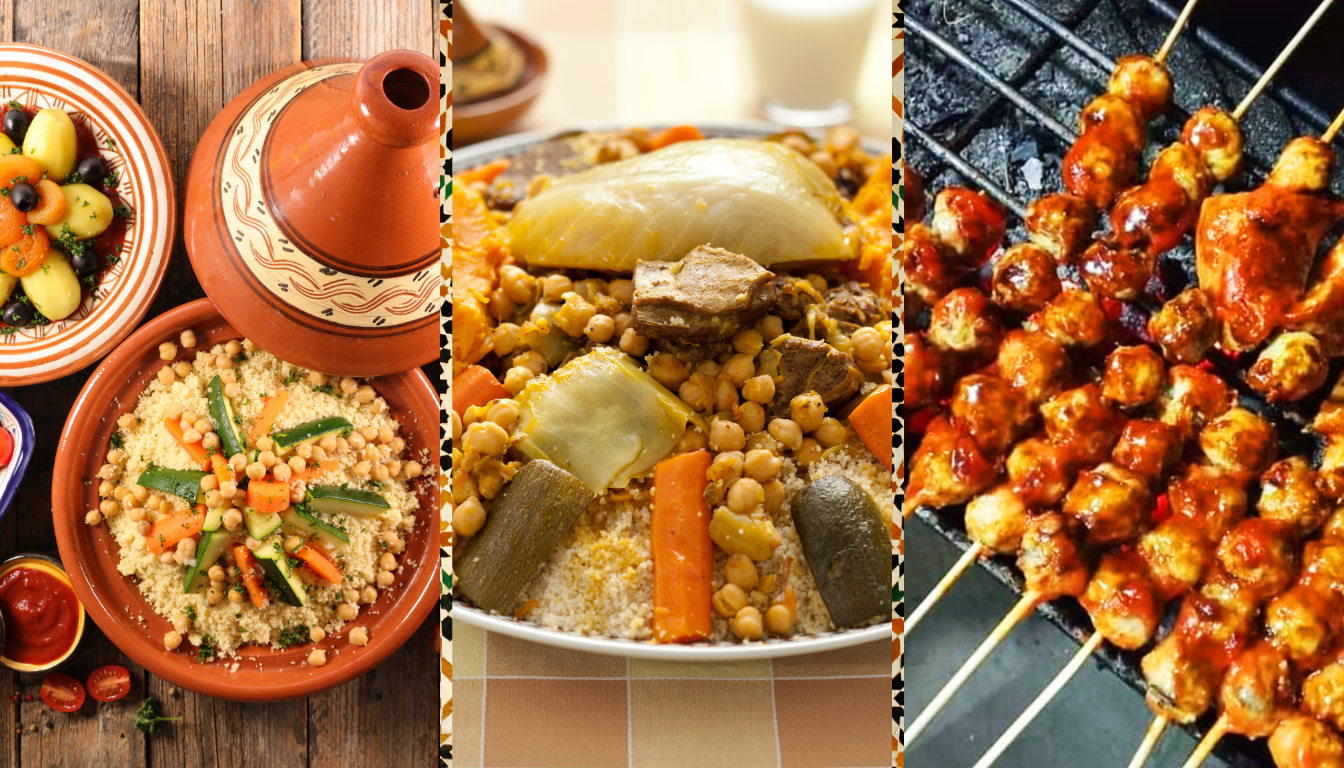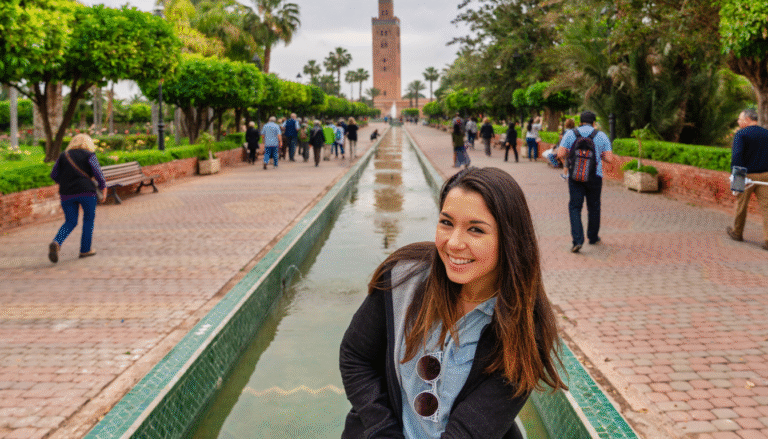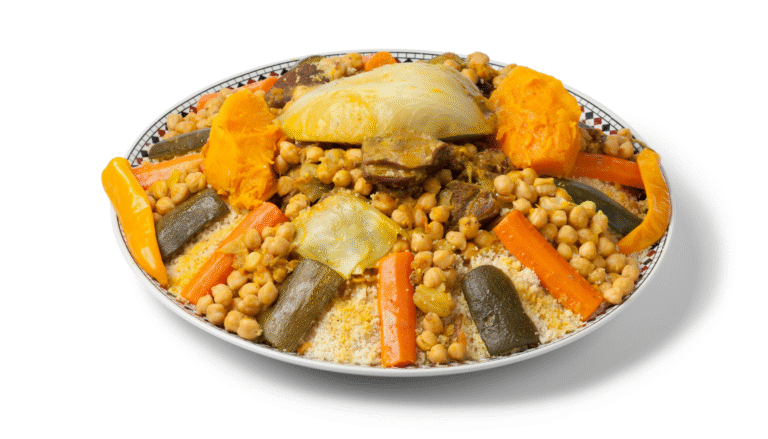What Moroccan Eat for Breakfast, Lunch, and Dinner?
Moroccan cuisine is a mix of Arab, Mediterranean, and Berber flavors. It’s known for its rich tastes and aromatic spices. In Morocco, meals are more than just food; they’re a big part of the culture and daily life.
The traditional Moroccan diet is very healthy. It focuses on fresh ingredients and healthy meal planning.
Exploring Moroccan cuisine shows the importance of breakfast, lunch, and dinner. From the hearty breakfast dishes to the big lunch and dinner feasts, every meal is a celebration. It’s a time to share flavors and community.
In this article, we’ll explore the traditional Moroccan meals. We’ll see what Moroccans typically eat for breakfast, lunch, and dinner. We’ll also show you how to add these healthy habits to your daily routine.
The Rich Tapestry of Moroccan Cuisine
Moroccan cuisine is a vibrant mix of the country’s diverse cultures. It has been shaped by many influences. This has created a unique taste experience that is both flavorful and aromatic.
The Influence of Berber, Arab, and Mediterranean Cultures
The cuisine of Morocco shows the country’s rich cultural heritage. It is influenced by Berber, Arab, and Mediterranean traditions. The Berber culture, native to Morocco, has greatly shaped the country’s food. Arab influences have brought in spices and ingredients that are now common in Moroccan cooking.
Mediterranean cuisine has also made its mark. It has introduced olive oil, citrus, and fresh herbs into Moroccan dishes.
This mix of cultures has given Morocco a unique culinary style.
Key Spices and Ingredients in Moroccan Cooking
Moroccan cuisine is known for its bold flavors. It uses a variety of spices and ingredients to achieve this. Key spices include cumin, coriander, cinnamon, and ginger, often mixed in complex blends like ras el hanout.
Preserved lemons and olives are also key, adding a salty, tangy flavor. Fresh herbs like parsley and cilantro add freshness and depth to Moroccan dishes.
Traditional Moroccan Breakfast Essentials
Starting your day with a traditional Moroccan breakfast is a joy. It’s filled with flavors and aromas that wake you up. This meal is key to a healthy day, setting the right tone.
Moroccan Bread Varieties: Khobz and Msemen
Moroccan breakfasts include many breads, like khobz and msemen. Khobz is a crusty round bread. Msemen is a folded flatbread, often with olive oil or honey. These breads are tasty and make a great start to the day.
Breakfast Accompaniments: Olive Oil, Honey, and Jams
No Moroccan breakfast is complete without certain accompaniments. Olive oil adds healthy fats to your meal. Honey and jams, made from local fruits, add sweetness. These add flavor and nutrition, making the meal balanced.
Moroccan Mint Tea: The Morning Ritual
Atay, or Moroccan mint tea, is a morning must. It’s a mix of green tea, fresh mint, and sugar. It’s refreshing and a sign of Moroccan hospitality, a daily tradition.
How to Prepare Authentic Moroccan Breakfast at Home
You can bring Moroccan flavors into your home with a tasty breakfast. Try making msemen and mint tea. To do this, you need traditional breads and tea, which need special ingredients and methods.
Step-by-Step Msemen Recipe
To make msemen, you need flour, water, salt, and oil. First, mix the dough and let it rest. Then, roll it out thin and fold it into a square.
- Mix 2 cups of flour with 1/2 teaspoon of salt and 1 tablespoon of oil.
- Add 1/2 cup of warm water and knead the dough.
- Let it rest for 30 minutes.
- Roll out the dough thinly and fold it into a square.
| Ingredient | Quantity |
|---|---|
| Flour | 2 cups |
| Water | 1/2 cup |
| Salt | 1/2 teaspoon |
Creating the Perfect Moroccan Mint Tea
Moroccan mint tea is a must-have for breakfast. You’ll need green tea, fresh mint, and sugar.
- Boil 1 cup of water and add 1 teaspoon of green tea.
- Add a handful of fresh mint leaves.
- Add sugar to taste.
By following these steps, you can enjoy a real Moroccan breakfast at home. It includes yummy msemen and refreshing mint tea.
The Significance of Lunch in Moroccan Culture
In Morocco, lunch is more than just a meal; it’s a cultural cornerstone. This midday meal plays a key role in Moroccans’ daily lives. It’s often the largest and most important meal of the day.
Family Gatherings and Midday Meals
Lunch is when families come together. They share traditional dishes and strengthen their bonds. The meal is a leisurely affair with multiple courses and lots of conversation.
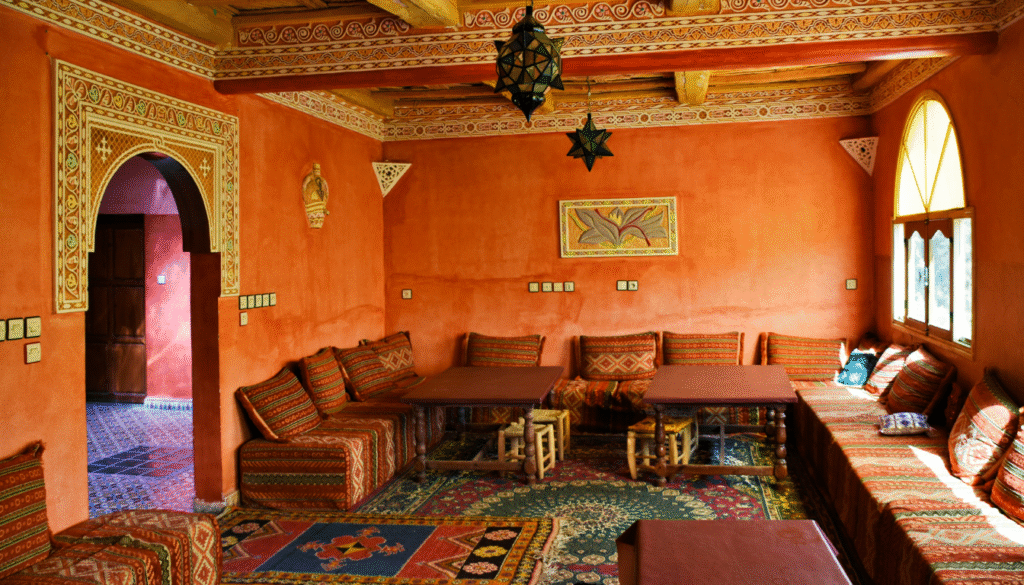
Traditional Lunch Timing and Customs
In Morocco, lunch is from 1 pm to 3 pm. This follows the Islamic practice of taking a break during the hottest part of the day. Before the meal, a refreshing glass of mint tea or other traditional beverages is served.
The slow and relaxed pace of lunch gives a moment of respite. It promotes a healthy mealtime routine.
What Moroccans Eat for Breakfast, Lunch, and Dinner Throughout the Week
Moroccan meal patterns change from weekdays to weekends. This is due to cultural, religious, and social factors.
Weekday vs. Weekend Meal Patterns
Weekdays are busy for Moroccans, so meals are quick. Breakfasts often include msemen or khobz with olive oil and jam. Lunches are big meals eaten with family, featuring dishes like tagines or couscous.
Weekends are for relaxing and enjoying meals. Sundays are for more elaborate cooking.
Weekdays and weekends differ in meal times and dishes. Weekends have more time for cooking and enjoying meals. They also have more varied and elaborate dishes.
Family gatherings are more common on weekends. This adds to the enjoyment of meals.
Regional Variations in Daily Eating Habits
Morocco’s regions influence daily meals. Coastal areas eat more seafood, while inland focuses on meat and veggies. The Atlas Mountains have heartier stews and soups because of the cold.
These regional differences help in eating a balanced diet. They use local ingredients and keep cultural cooking alive.
Exploring these variations helps understand nutritional habits. It shows how they contribute to a balanced diet.
Mastering the Art of Moroccan Tagine
To truly experience Moroccan cuisine, mastering the art of cooking tagine is key. Tagine is a slow-cooked stew named after the clay pot it’s cooked in. It’s more than just a dish; it’s a symbol of Moroccan hospitality and rich culinary heritage.
Essential Equipment and Ingredients
Cooking an authentic Moroccan tagine needs specific equipment and ingredients. The traditional clay pot with a conical lid is vital for slow-cooking. Key ingredients include aromatic spices, meats or vegetables, and sometimes preserved lemons or olives.
Step-by-Step Chicken Tagine with Preserved Lemon
To make a delicious chicken tagine with preserved lemon, start by browning the chicken in olive oil and butter. Next, add onions, garlic, ginger, and spices. Then, add chicken broth and preserved lemons. Let it simmer until the chicken is tender and flavors are combined.
Tips for Perfect Tagine Every Time
To ensure your tagine is perfect, follow a few key tips. First, brown your meat or vegetables before slow-cooking to boost flavor. Second, use a variety of spices for depth of flavor. Lastly, be patient and let it cook slowly for the best flavors.
How to Make Traditional Friday Couscous
Making couscous is a cherished tradition in Morocco, most on Fridays. It’s a dish from semolina flour, key in Moroccan food. It symbolizes unity and togetherness.
Preparing the Couscous Grains Properly
To make couscous, steaming is key. Steaming makes the grains separate, creating a light, fluffy texture. Use a couscous steamer or a metal steamer pot. Rinse the grains and steam them for 30 minutes until they’re tender and separate.
Creating a Flavorful Vegetable and Meat Topping
The couscous topping is a mix of veggies and meat, like lamb or chicken. Start by browning the meat in olive oil. Add veggies like carrots, zucchini, and onions, along with broth and spices. Simmer until the veggies are tender. Chickpeas or raisins add extra flavor and texture.
| Ingredient | Quantity | Preparation |
|---|---|---|
| Couscous | 1 cup | Steamed |
| Lamb or Chicken | 1 pound | Browned |
| Vegetables | 2 cups | Sautéed |
Serving and Eating Couscous the Moroccan Way
To serve couscous traditionally, place it on a large platter and top it with the meat and veggie mix. Use your right hand to shape the couscous into small balls. This communal eating is a big part of Moroccan culture, fostering unity and togetherness.
By following these steps, you can enjoy a delicious, authentic Friday couscous meal. It not only tastes great but also adds to your daily food intake of healthy, nutritious food.
Dinner Traditions in Moroccan Households
As the day ends, Moroccan families come together for dinner. This meal is lighter than lunch. It’s a key part of their daily life, helping them eat well and bond as a family.
Lighter Evening Meals: Soups and Stews
In Morocco, dinner often means soups and stews. These dishes are tasty and good for you. Harira, a mix of tomatoes, lentils, and chickpeas, is a favorite.
These meals are great for the evening. They’re easy to digest and bring comfort. A typical dinner might also include a salad or bread with olive oil.
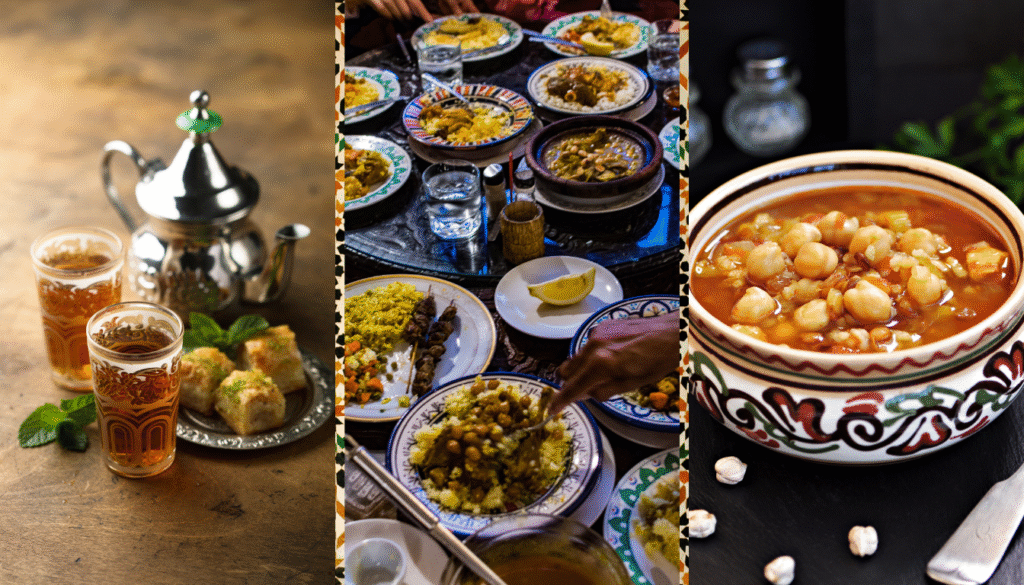
Dinner Timing and Family Customs
Dinner times in Moroccan homes vary. It depends on the season and family traditions. Usually, dinner is between 7 pm and 9 pm.
Special times like Ramadan or holidays can change the dinner time. Family customs are important in setting dinner traditions.
| Dinner Time | Customs |
|---|---|
| 7 pm – 8 pm | Typical dinner hour during winter months |
| 8 pm – 9 pm | Common dinner time during summer months or Ramadan |
Family customs shape dinner traditions. For example, on special days, families might eat earlier and have a bigger meal. The focus is always on being together and enjoying each other’s company.
Preparing Harira: Morocco’s Beloved Soup
Harira is a delicious soup from Morocco. It’s made with tomatoes, lentils, and chickpeas. This soup is a big part of Morocco’s nutritional eating habits. It’s great as a starter or main dish, fitting into any meal plan.
Gathering the Ingredients
To make harira, you need tomatoes, lentils, chickpeas, onions, and spices. The quality of these ingredients and the spices’ balance are key. You can adjust the amounts based on your taste and how many you’re serving.
Step-by-Step Cooking Process
First, sauté onions and spices in olive oil until they smell good. Then, add the tomatoes, lentils, and chickpeas. Stir well. Next, pour in vegetable broth and let it boil, then simmer until the lentils are soft. Season with salt and pepper to taste.
Serving Suggestions and Accompaniments
Harira is best enjoyed hot, with dates and crusty bread. It’s a comforting meal that’s healthy and fulfilling. It’s perfect for a dining schedule that values both health and taste.
| Ingredient | Quantity | Purpose |
|---|---|---|
| Tomatoes | 2 cups | Base flavor |
| Lentils | 1 cup | Protein and texture |
| Chickpeas | 1 cup | Additional protein and fiber |
Incorporating Moroccan Meal Patterns into Your American Lifestyle
Exploring Moroccan cuisine can add variety to your meals and introduce new tastes. By adopting Moroccan eating habits, you can make your diet more balanced and interesting.
Adapting Moroccan Recipes with Local Ingredients
To make Moroccan dishes easier to make, swap local ingredients for the traditional ones. For example, use common vegetables instead of rare ones. This way, you can enjoy Moroccan flavors without sacrificing freshness or availability.
Creating a Balanced Diet with Moroccan Inspiration
Moroccan food is rich in nutrients. Adding more vegetables, whole grains, and lean proteins to your meals can make your diet healthier. Try a hearty tagine with chicken, veggies, and couscous for a nutritious meal.
Time-Saving Tips for Authentic Moroccan Cooking
To save time, prep ingredients ahead and use leftovers in creative ways. For example, turn leftover tagine into a tasty sandwich or wrap. Also, cooking in bulk and freezing meals can be helpful.
| Time-Saving Tip | Description | Benefit |
|---|---|---|
| Prepare ingredients in advance | Chop vegetables, marinate meats | Reduces cooking time |
| Use leftovers creatively | Transform leftovers into new dishes | Reduces food waste |
| Cook in bulk | Prepare large batches of meals | Saves time during the week |
Conclusion: Embracing the Rhythms of Moroccan Dining
Exploring Morocco’s rich food culture has given you new ideas for your meals. You now know how important meals are in Moroccan culture. This knowledge can help you enjoy their food more and eat healthier.
Moroccan food is known for its bold flavors and traditional ingredients. Adding these to your meals can make your diet healthier. Start by making Moroccan dishes with ingredients you have at home. Try different meals each day to see what works best for you.
Embracing Moroccan dining can make your diet more balanced. Try adding dishes like tagine, couscous, and harira to your meals. With these new recipes, you’ll enjoy the delicious tastes and health benefits of Moroccan food.

